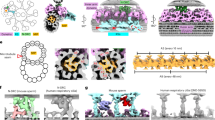Summary
Elongated microvilli attach the early sea urchin embryo to the fertilization envelope and support it in a concentric position within the perivitelline space. The contractility of the elongated microvilli was demonstrated in several ways. (1) During normal cleavage, these microvilli change their length to adapt to the change in shape and numbers of blastomeres. (2) When treated with calcium-free sea water, embryos become eccentrically located and the microvilli extend further than normal on one side; when returned to normal sea water, the embryos become centered again. (3) Several agents cause the fertilization envelope to become higher and thinner than normal and the elongated microvilli to extend correspondingly if treated within ten min after fertilization. In some cases, both elongated microvilli and fertilization envelope return to normal size when returned to normal sea water. (4) Fertilization in a papain solution causes the elongated microvilli and the fertilization envelope to contract to the surface of the embryo. (5) Refertilization after the papain-induced contraction can bring about the elongation of these microvilli and the elevation of the fertilization envelope a second time. It was also shown that elongated microvilli are extended immediately upon fertilization, at the same time as the short microvilli. The firm adherence of the tips of elongated microvilli to the fertilization envelope by means of extracellular matrix fibers is shown in a high voltage electron microscope stereoimage. This allows us to understand why it is that when the elongated microvilli extend or contract, the fertilization envelope also extends and contracts accordingly.
Similar content being viewed by others
References
Allen RD, Allen NS (1983) Video-enchanced microscopy with a computer frame memory. J Microsc 129:3–17
Arpin M, Pringault E, Finidori J, Garcia A, Jeltsch J-M, Vankekerckhove J, Louvard D (1988) Sequence of human villin: A large duplicated domain homologous with other actin-severing proteins and a unique small carboxy-terminal domain related to villin specificity. J Cell Biol 107:1759–1766
Bazari WL, Matsudaira P, Wallek M, Smeal T, Jakes R, Ahmed Y (1988) Villin sequence and peptide map identify six homologous domains. Proc Natl Acad Sci USA 85:4986–4990
Begg DA, Rebhun LI, Hyatt H (1982) Structural organization of actin in the sea urchin egg cortex: Microvillar elongation in the absence of actin filament bundle formation. J Cell Biol 93:24–32
Chandler DE, Heuser J (1979) Membrane fusion during secretion: Cortical granule exocytosis in sea urchin eggs studied by quickfreezing and freeze-fracture. J Cell Biol 83:91–108
Citkowitz E (1971) The hyaline layer: Its isolation and role in echinoderm development. Dev Biol 24:348–362
Dan K (1960) Cyto-embryology of echinoderms and amphibia. Int Rev Cytol 9:321–367
Fisher GW, Rebhun LI (1983) Sea urchin egg cortical granule exocytosis is followed by a burst of membrane retrieval via uptake into coated vesicles. Dev Biol 99:456–472
Fisher GW, Summers RG, Rebhun LI (1985) Analysis of sea urchin egg cortical transformation in the absence of cortical granule exocytosis. Dev Biol 109:489–503
Friederich E, Huet C, Arpin M, Louvard D (1989) Villin induces microvilli growth and actin redistribution in transfccted fibroblasts. Cell 59:461–475
Giudice G, Mutolo V (1970) Reaggregation of dissociated cells of sea urchin embryos. Adv Morphol 8:115–158
Gustafson T, Wolpert L (1967) Cellular movement and contact in sea urchin morphogenesis. Biol Rev 42:442–498
Herbst C (1900) Über das Auseinandergehen von Furchungs und Gewebezellen in kalkfreiem Medium. Roux Arch Entwick Organ 9:424–463
Hiramoto Y (1954) Nature of the perivitelline space in sea urchin eggs I. Jpn J Zool 11:227–244
Hiramoto Y (1955) Nature of the perivitelline space in sea urchin eggs II. Jpn J Zool 12:1–14
Inoué S (1986) Video microscopy. Plenum Press, New York
Kidd P, Mazia D (1980) The ultrastructure of surface layers isolated from fertilized and chemically stimulated sea urchin eggs. J Ultrastr Res 70:58–69
Oshima N (1983) Mechanical properties of perivitelline fibers of sea urchin eggs as studied by application of centrifugal and eletrophoretic forces. Biol Bull 164:483–492
Rebhun LI, Begg DA, Fisher G (1982) Reorganization of the cortex of sea urchin eggs as a function of activation. Cell Diff 11:271–276
Sato H, Owaribe K, Miki-Noumura T (1973) Existence of surface fibers in perivitelline space. Proc 44th Ann Mtg Zool Soc Japan, Tokyo. Abstr 239 (in Japanese)
Schroeder TE (1979) Surface area change at fertilization: Resorption of the mosaic membrane. Dev Biol 70:306–326
Spiegel M, Burger M (1982) Cell adhesion during gastrulation: A new approach. Exp Cell Res 139:377–382
Spiegel E, Howard L, Spiegel M (1989a) The extracellular matrix of sea urchin and other marine invertebrate embryos. J Morphol 199:71–92
Spiegel E, Howard L, Spiegel M (1989b) Elongated microvilli support the sea urchin embryo concentrically within the perivitelline space until hatching. Roux's Arch Dev Biol 198:85–91
Spiegel E, Spiegel M (1977) A scanning electron microscope study of early sea urchin reaggregation. Exp Cell Res 108:413–420
Spiegel E, Spiegel M (1979) The hyaline layer is a collagen-containing extracellular matrix in sea urchin embryos and reaggregating cells. Exp Cell Res 123:434–441
Spiegel E, Spiegel M (1980) The internal clock of reaggregating embryonic sea urchin cells. J Exp Zool 213:271–281
Spiegel E, Spiegel M (1986) Cell-cell interactions during sea urchin morphogenesis. In: Browder LW (ed) Developmental Biology Vol. 2, The cellular basis of morphogenesis. Plenum Press, New York, pp 195–240
Tyler A, Spiegel M (1956) Elevation and retraction of the fertilization membrane of echinoderm eggs fertilized in papain solutions. Biol Bull 110:196–200
Author information
Authors and Affiliations
Rights and permissions
About this article
Cite this article
Spiegel, E., Howard, L. & Spiegel, M. The contractility of elongated microvilli in early sea urchin embryos. Roux's Arch Dev Biol 199, 228–236 (1990). https://doi.org/10.1007/BF01682082
Received:
Accepted:
Issue Date:
DOI: https://doi.org/10.1007/BF01682082




